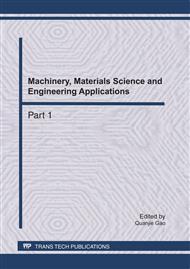[1]
I. Hamerton & J.N. Hay. Recent Developments in the Chemistry of Cyanate Esters. Polym Int 1998, 47.
DOI: 10.1002/(sici)1097-0126(199812)47:4<465::aid-pi88>3.0.co;2-s
Google Scholar
[2]
W.K. Goertzen, M.R. Kessler. Composites: Part A Vol. 39 (2008), p.761.
Google Scholar
[3]
S. A. Srinivasan, J.E. Mcgrath. Polymer Vol. 39 (1998), p.2415.
Google Scholar
[4]
S.K. Karad, F.R. Jones, D. Attwood. Polymer Vol. 43 (2002), p.5643.
Google Scholar
[5]
M. F. Zeng, X. D. Sun, Y. Wang, M. Z. Zhang, Y. M. Shen, B. Y. Wang and C. Z. Qi. Polym Adv Technol Volume Vol. 19 (2008), p.1664.
Google Scholar
[6]
X. R. Wu, S. N. Yi, W. L. Xie, Y. J. Liu, X. Y. Song. Dental Materials Vol. 26 (2010), p.456.
Google Scholar
[7]
A. Fina, D. Tabuani, G. Camino. Eur Polym J Vol. 46 (2010), p.14.
Google Scholar
[8]
Z. P. Zhang, G. Z. Liang, T. L. Lu. J Appl Polym Sci Vol. 103 (2007), p.2608.
Google Scholar
[9]
T. L. Lu., G. Z. Liang, K. C. Kou, Z. A. Guo. J Mater Sci Vol. 40 (2005), p.4721.
Google Scholar
[10]
Z. P. Zhang, G. Z. Liang, J. L. Wang, P. G. Ren. Polym Compos Vol. 28 (2007), p.175.
Google Scholar
[11]
Z. P. Zhang, G. Z. Liang, P. G. Ren, J. L. Wang, J. Q. Xie, X. L. Wang. Polym Degrad Stab Vol. 92 (2007), p. (1986).
Google Scholar
[12]
T. L. Lu., G. Z. Liang, Z. A. Guo. J Appl Polym Sci Vol. 101 (2006), p.3652.
Google Scholar
[13]
Y. D. Zhang, S. H. Lee, M. Yoonessi, K. W. Liang, C. U. Pittman. Polymer Vol. 47 (2006), p.2984.
Google Scholar
[14]
S. A. Madbouly, J. U. Otaigbe. Prog Polym Sci Vol. 34 (2009), p.1283.
Google Scholar
[15]
J. K. Herman Teo, K. C. Teo, B. H. Pan, Y. Xiao, X. H. Lu. Polymer Vol. 48 (2007), p.5671.
Google Scholar
[16]
P. G. Ren, G. Z. Liang and Z. P. Zhang. Polym Compos Vol. 27 (2006), p.402.
Google Scholar
[17]
M. Abdalla, D. Dean, P. Robinson, Nyairo E. Polymer Vol. 49 (2008), p.3310.
Google Scholar
[18]
G. Z. Liang, P. G. Ren, Z. P. Zhang and T. L. Lu. J Appl Polym Sci Vol. 101 (2006), p.1744.
Google Scholar
[19]
L. Zhao, X. Hu. Polymer Vol. 51 (2010), p.3814.
Google Scholar
[20]
S. C. Xu. Organic Chemistry, Higher Education Press, 2nd edition, p. (1991).
Google Scholar
[21]
K. L. Xie, X. R. Gao, W. G. Zhao. Carbohydr Polym Vol. 81 (2010), p.300.
Google Scholar


